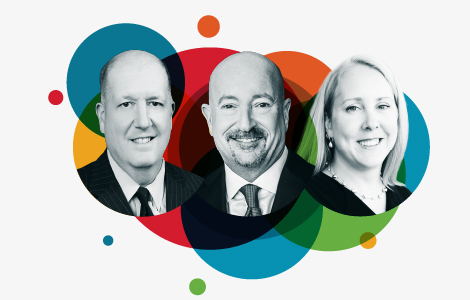
Disruptions caused by COVID drew more attention to supply chains than ever before. But even before the pandemic, supply chain planning practices were changing toward leaner models in a quest for more efficient supply chains.
However, decisions that were made to create leaner supply chains came at the cost of resiliency. It wasn’t long before these new supply chain planning practices led to instability and ultimately higher costs as companies around the globe reacted to disruption. So, how do you create supply chain stability and still be successful when the world is unstable?
To discuss why and how to build resiliency into supply chain decisions, Mike Corbo, former Chief Supply Chain Officer of Colgate-Palmolive, joins Board Member and Supply Chain Innovator Angel Mendez and Kinaxis Chief Strategy Officer, Dr. Anne Robinson, in part two of their Big Ideas in Supply Chain podcast conversation. (Watch part one of this series hosted by Angel and Anne.)
Here are some of the takeaways from their discussion.
Lessons from COVID
COVID was a learning experience for supply chain practitioners. Previously, if there was a disruption like an earthquake or fire, supply chain practitioners would ask, “What is the expected duration? How impactful is it? How wide of an impact is it?” With COVID, there was no idea of duration, it had worldwide impact, and it affected every part of people’s lives.
To an experienced supply chain practitioner like Mike, the key to weathering this major disruption happened over a decade before the pandemic began. He says, “We had spent a good decade on risk management. Having back-up supplies. We started changing suppliers and validating people in record time.” Mike, who has over 40 years of supply chain experience, notes that it was part of a playbook the company developed to manage disruption. Being able to quickly add and change suppliers helped Colgate-Palmolive succeed in the short term.
The other shift that took place at Colgate-Palmolive had to do with decision-making. With multiple breakdowns occurring at the same time, the company couldn’t wait for all decisions to be made by the Chief Supply Chain Officer. Early in the pandemic this hierarchy of decisions was changed, empowering other practitioners to make decisions so one individual wouldn’t bottleneck the process. This drastically improved efficiency which helped Colgate-Palmolive reduce reaction time from 60 - 90 days to only 7 - 8 days.
Not only did this approach allow for Colgate-Palmolive to grow revenue during this time, it increased C-suite focus on the supply chain. This allowed Mike to reinforce his message of stability to shareholders and the Board of Directors. “Costs aren’t going to come down anytime soon, but if I can procure things in a stable way, we could start to stabilize the outcomes,” he says.
Balancing resiliency with efficiency
Creating supply chain stability in an unstable world is no easy task, but the great news is it’s possible with the right planning.
Mike says the key lies in balancing efficiency and resiliency. Previously, companies tried to make their supplies chains too lean to maximize efficiency. By trying to make things cheaper and cheaper, companies began to let cracks form, reducing how resilient their supply chains were. And when disruption happens, that kind of foundation can fall apart.
To create supply chain stability, Mike suggests you need to have resiliency built into all your decisions. This will result in certain losses of efficiency — building in redundancies and planning for multiple variations of something may increase costs. But it also can prevent major disruption. Mike recalls Colgate-Palmolive’s shift from single-source suppliers and the impact it had: “Sometime around a decade ago we started to unravel that and said we have too many single-source suppliers, started to get redundant suppliers, (so we) moved the business to multiple sources. That really served us well, because the people that were stuck with one supplier out of China for their supply chain were dead.”
Preparing for tomorrow
Supply chain leaders of tomorrow will need to perform their own balancing act, Mike suggests. For supply chain planners, a balanced approach between cost and service must be accompanied by having their voice heard on the revenue side. They must suggest innovative ways to drive revenue on a consistent basis and create opportunities to drive more revenue. “We can’t just be put in a cost basket and kept to the side. And there’s where it came from, but I’m very hopeful that’s not where it’s going.”
To hear more from Mike, Angel and Anne about building resilience in supply chain decisions, watch the full podcast now:
Don't forget to check out more of our insightful Big Ideas in Supply Chain podcast episodes here!




